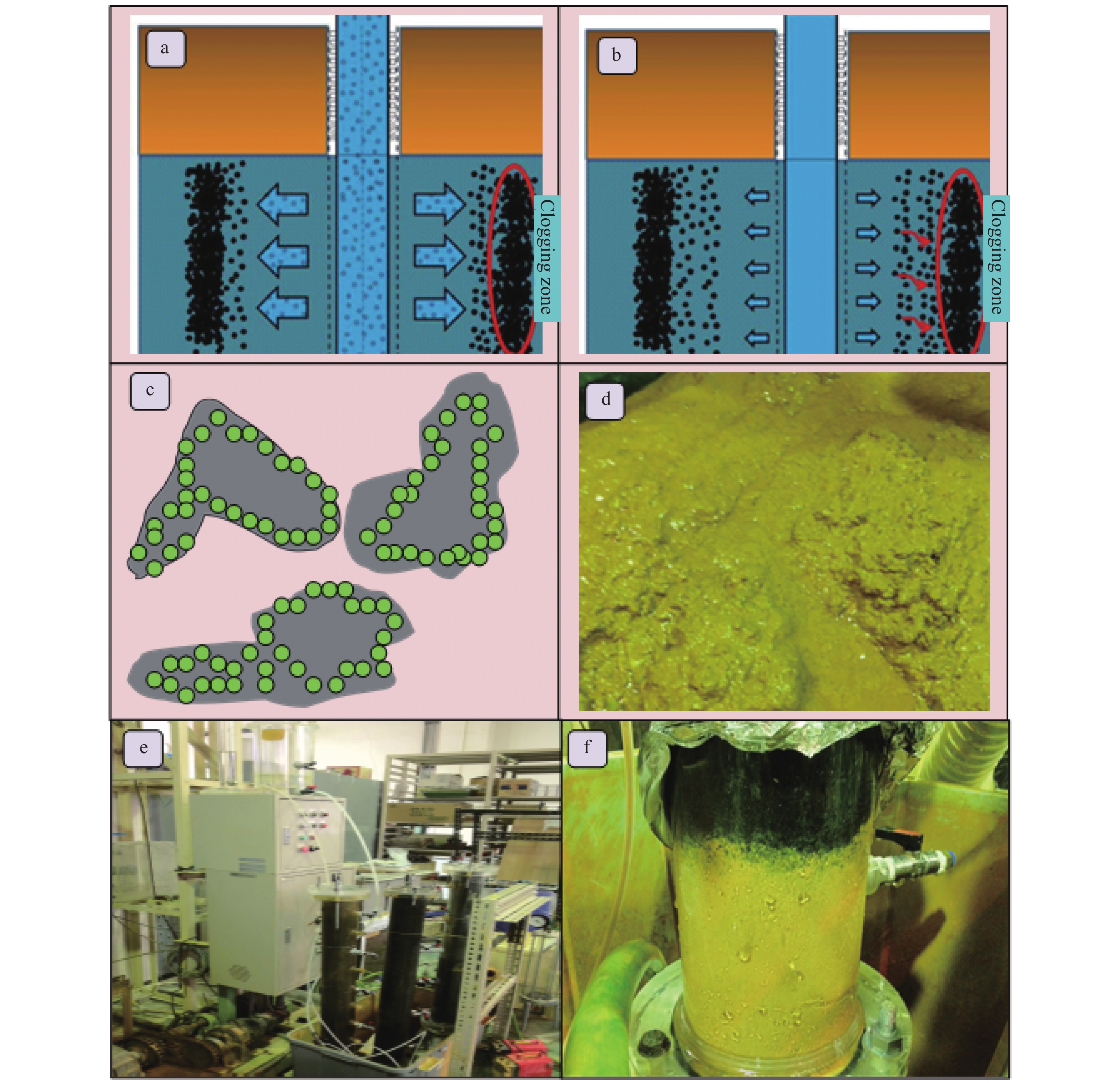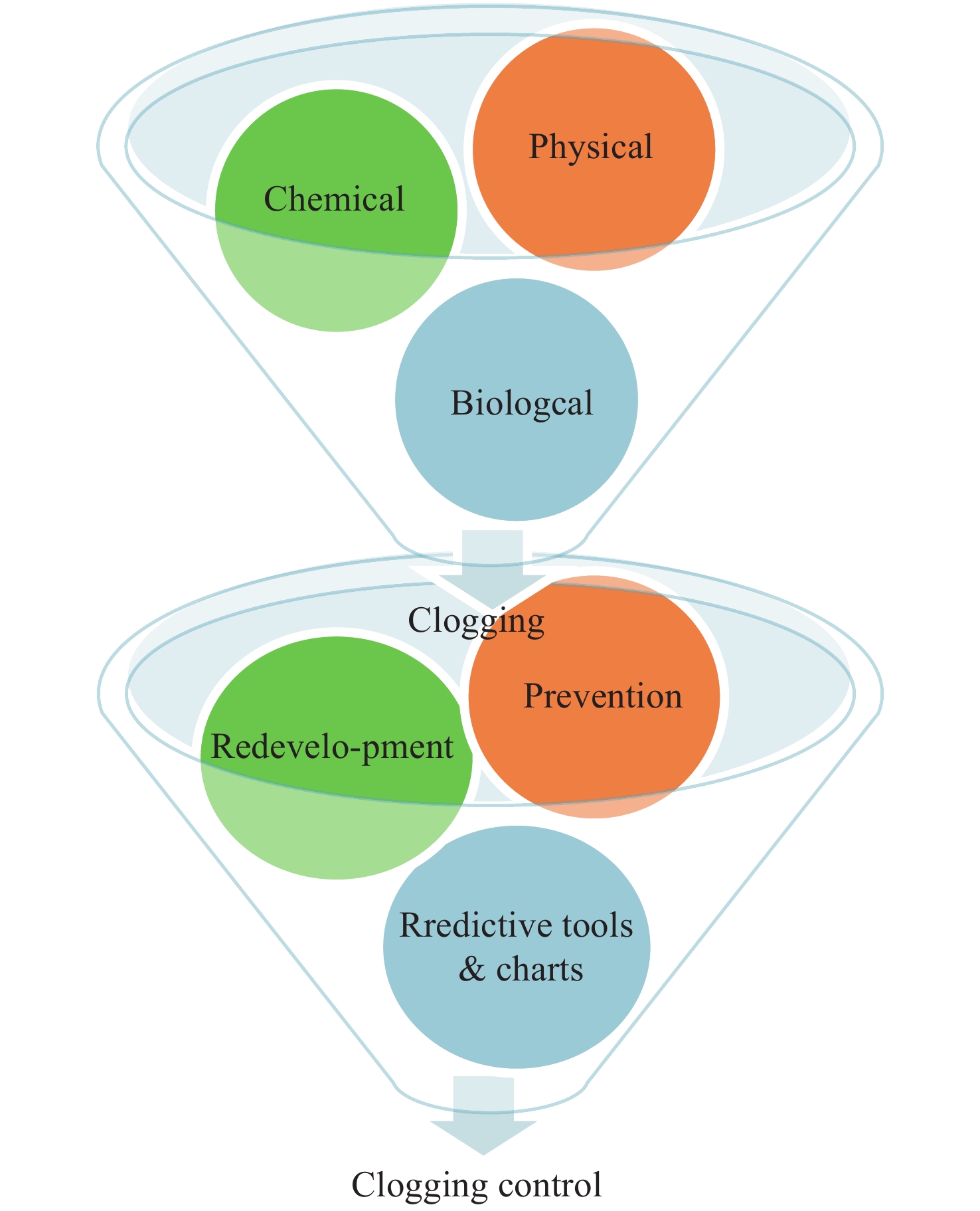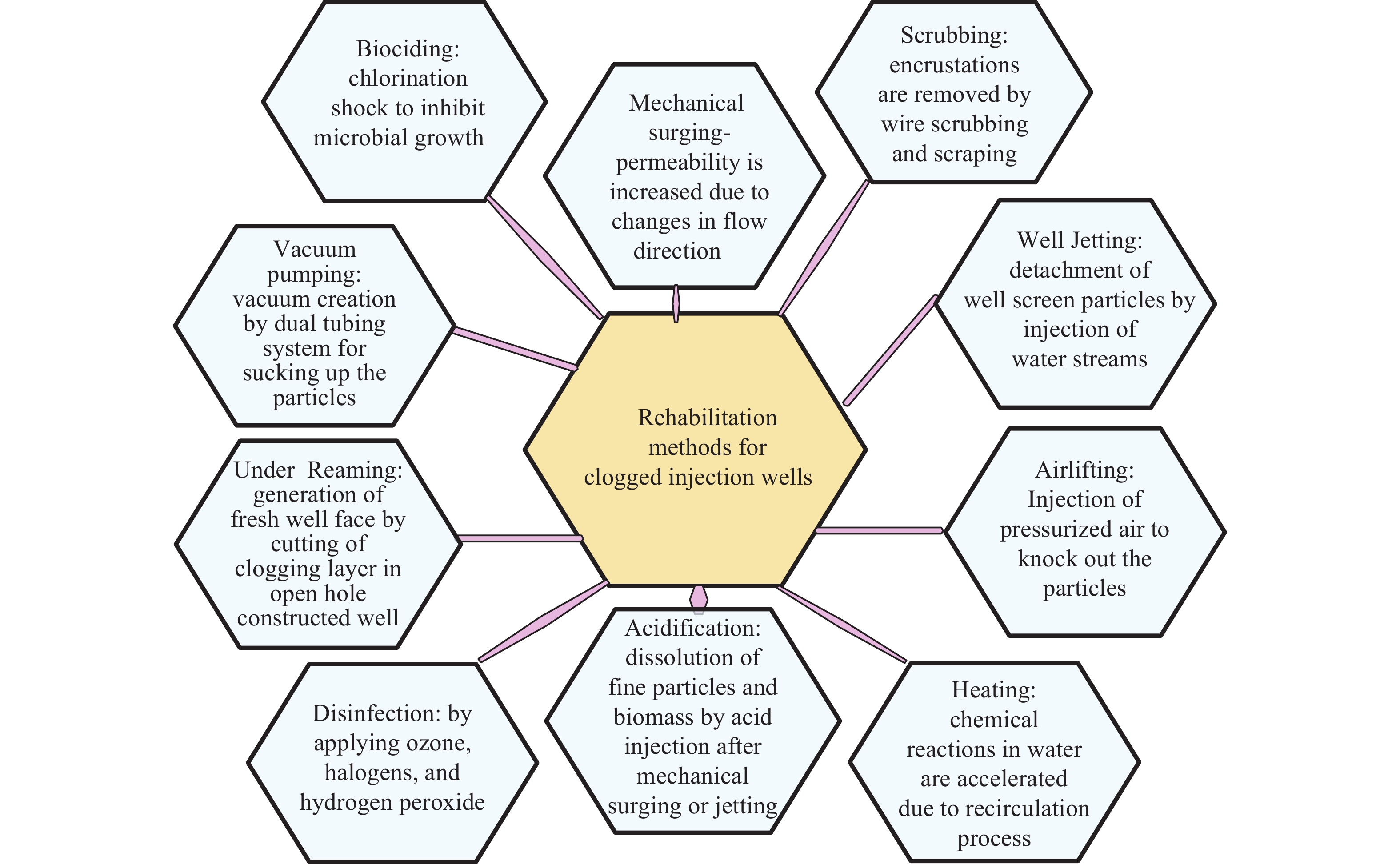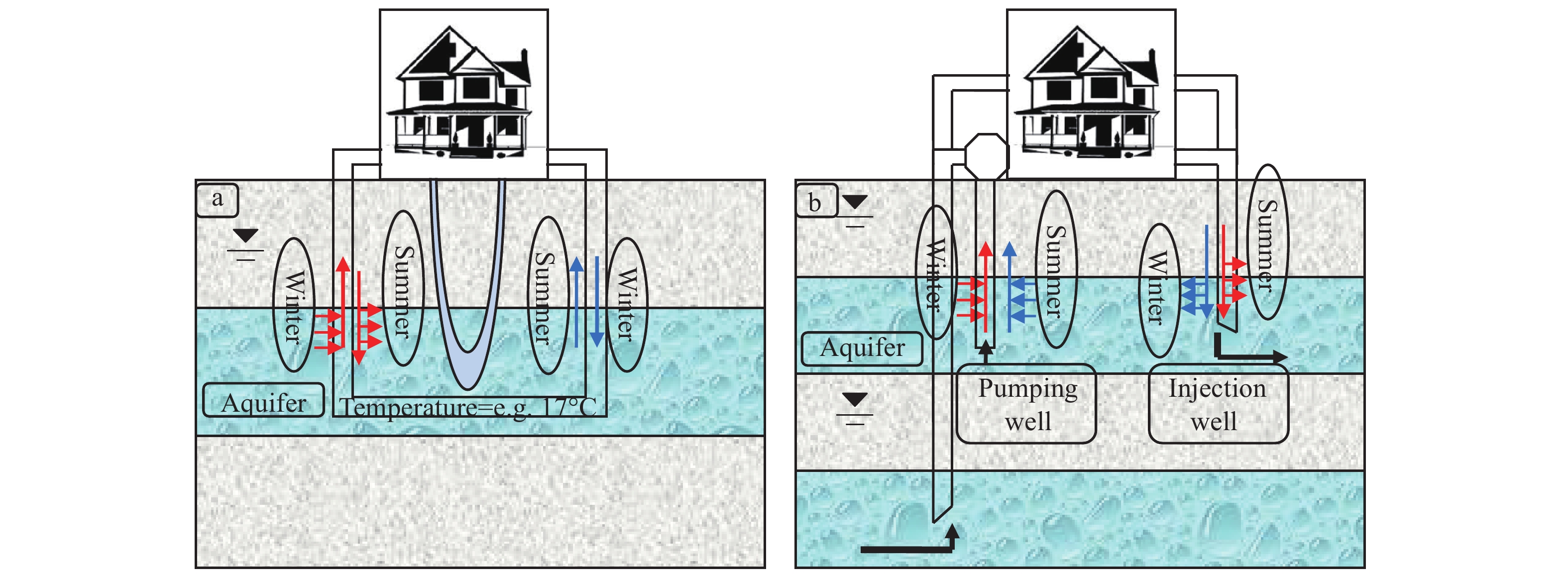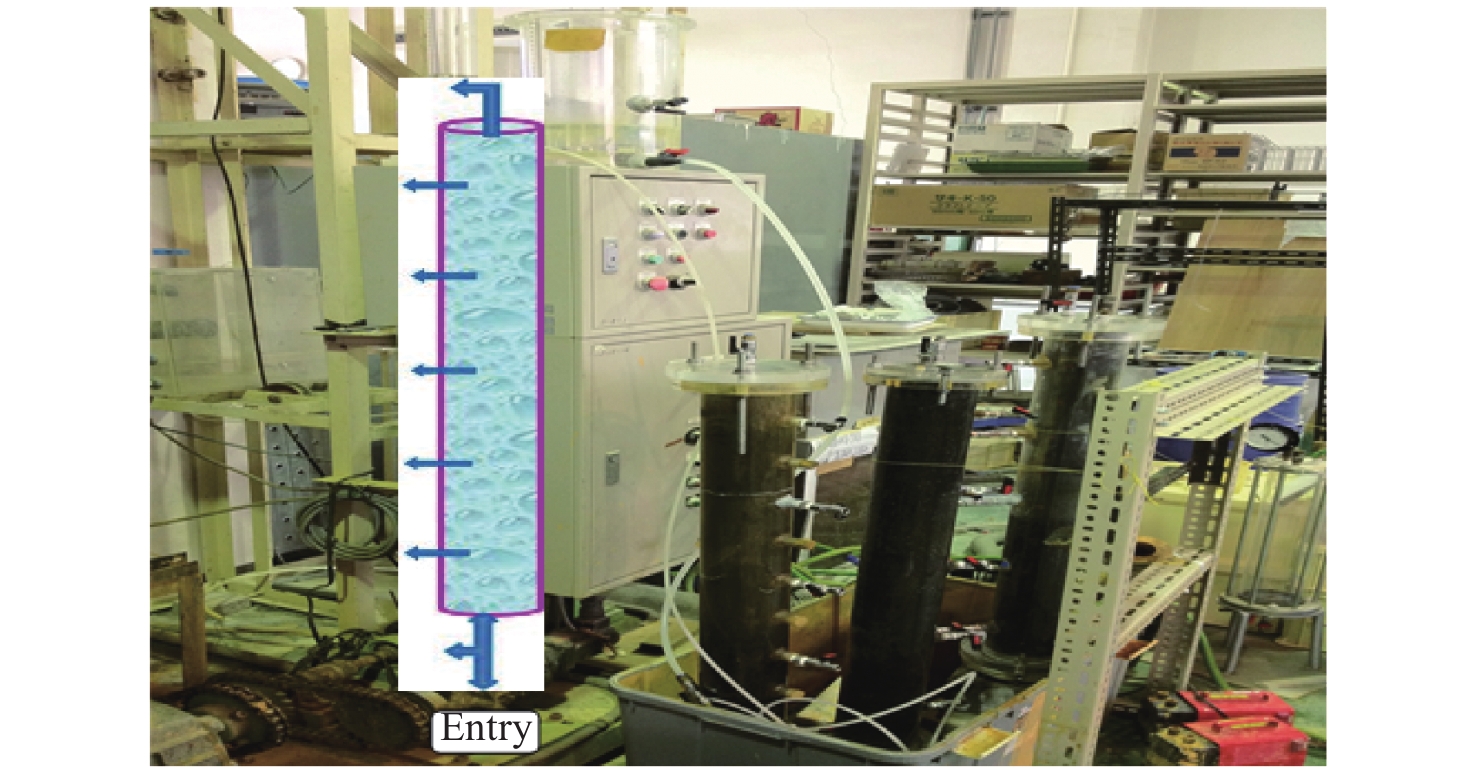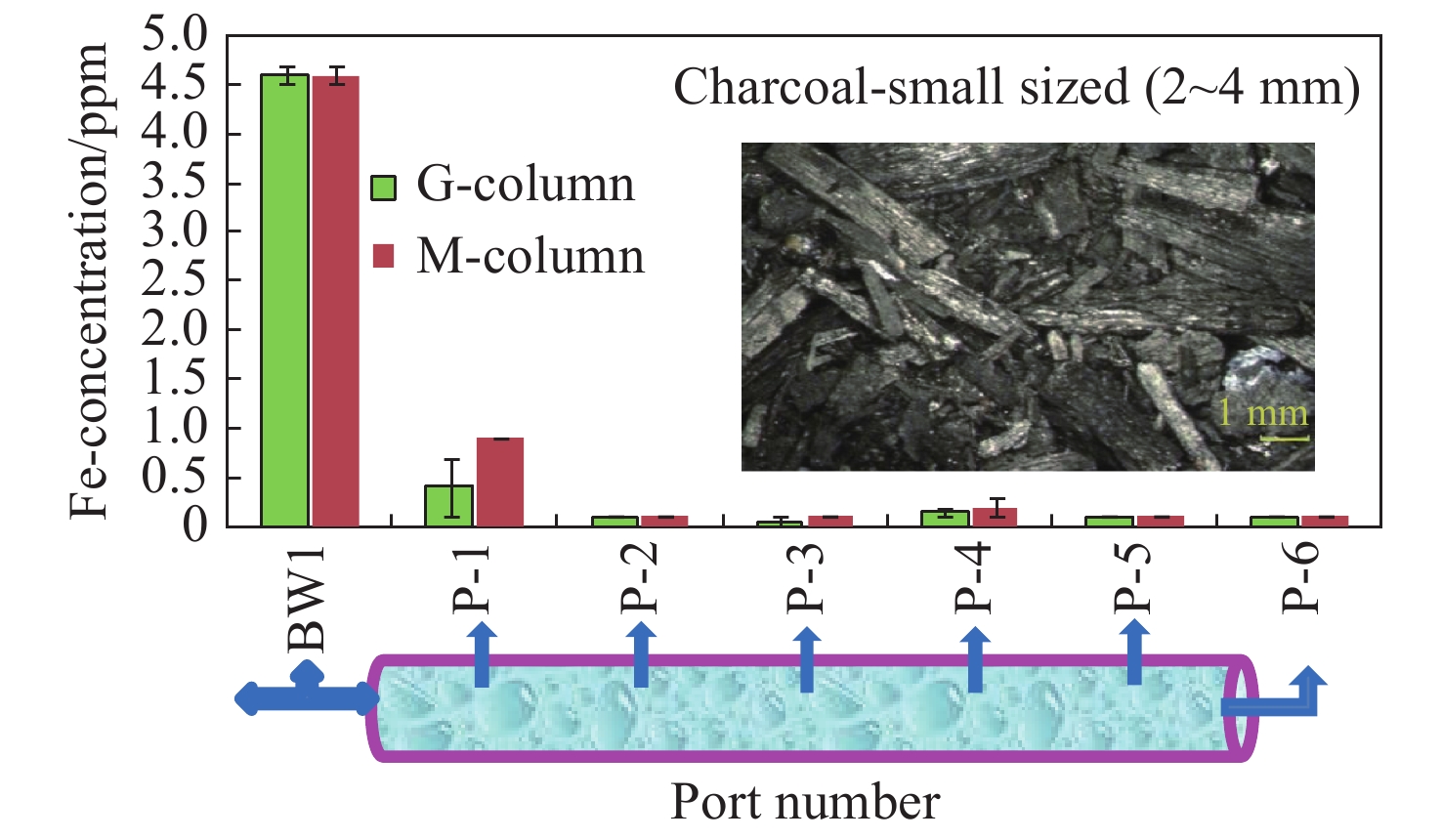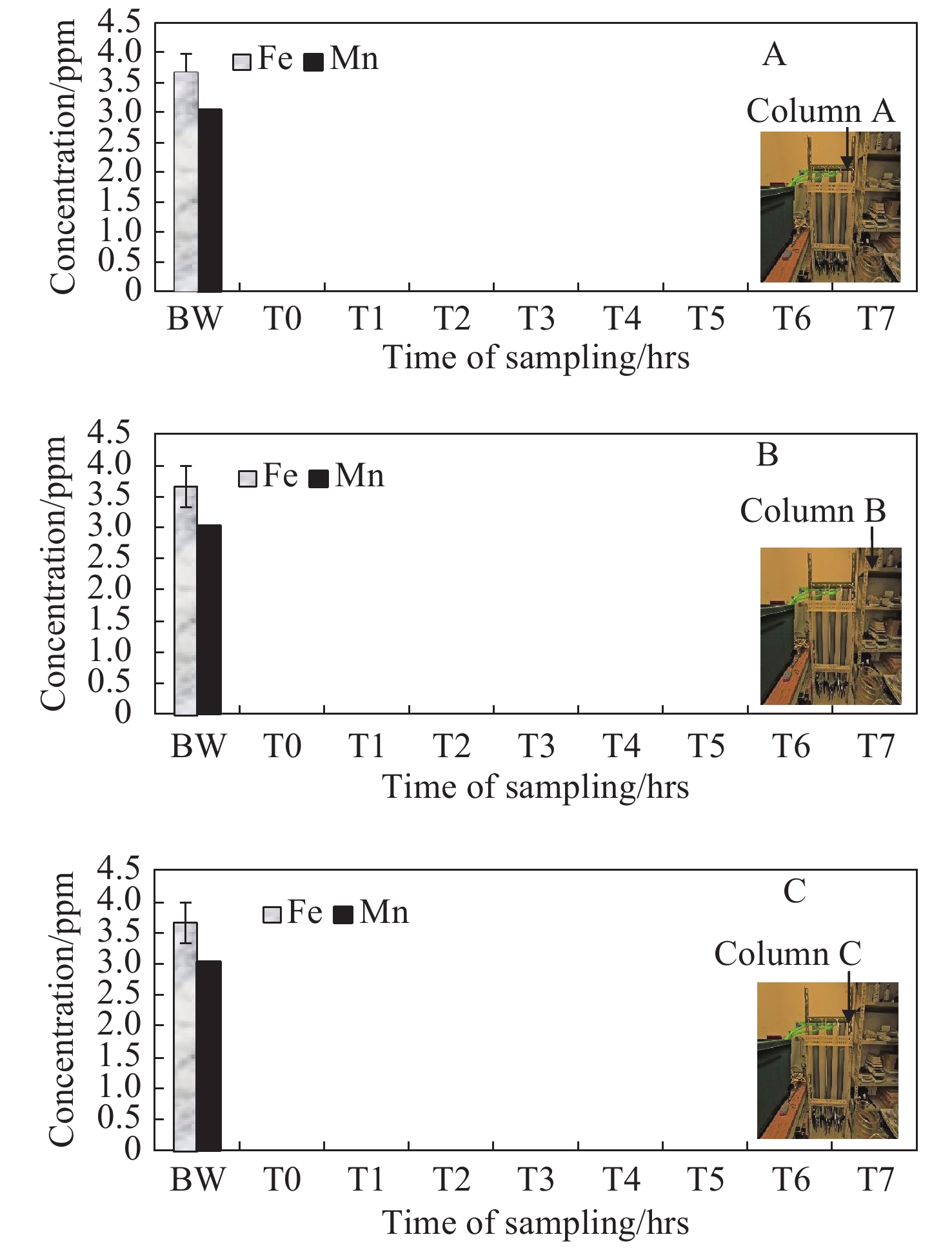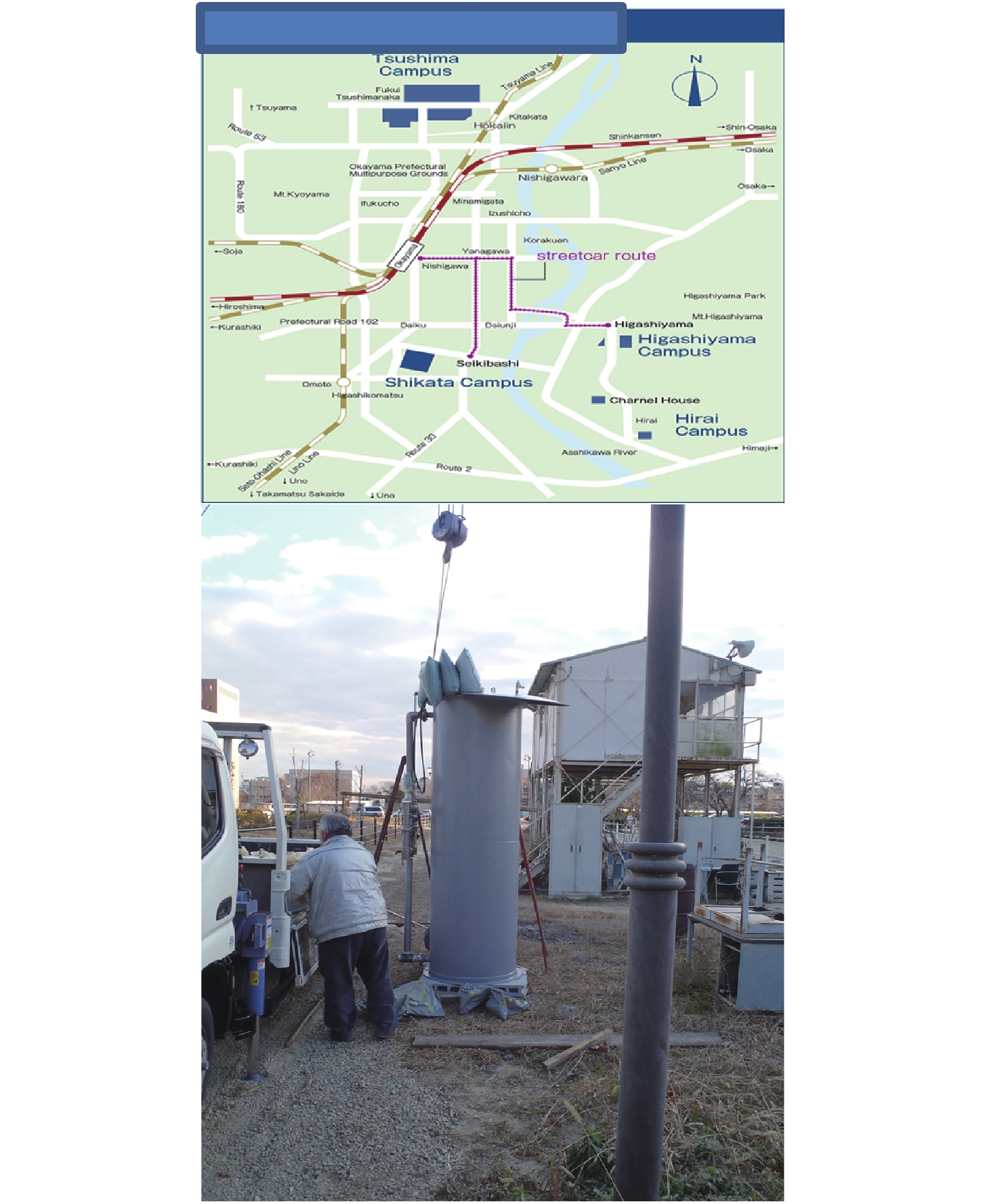| Citation: | Shahbaz Akhtar M, Nakashima Yoshitaka, Nishigaki Makoto. 2021. Clogging mechanisms and preventive measures in artificial recharge systems. Journal of Groundwater Science and Engineering, 9(3): 181-201. doi: 10.19637/j.cnki.2305-7068.2021.03.002 |
Clogging mechanisms and preventive measures in artificial recharge systems
-
Abstract
Groundwater which occurs in fractured rock or porous aquifers or other geological weak zones such as faults and fractures is usually extracted via boreholes, hand wells or other sources such as springs. Water scarcity has become a severe problem due to many factors, such as an alarming increase in population and per capita water consumption, over exploitation of groundwater resources and abrupt global climatic change along with its related eco-environmental geological problems. In such situation, application of artificial recharge systems (e.g. surface recharge basin and deep injection well systems) can help to effectively manage and augment the unitization of groundwater resources. However, the clogging problem, which may be caused by a complex interdependent mechanisms of physical, chemical and biological has been a challenge for the efficacy and the implementation of recharge facilities. Clogging can reduce the permeability, recharge rate and longevity of recharge facilities and increase the operational and maintenance costs. Major influencing factors associated with the occurrence of clogging include the chemical composition of groundwater (both the recharge water and native groundwater), aquifer medium and microbial diversity, together with other environmental factors such as temperature, pressure, total dissolved solids, total soluble salts, pH, Eh, nutrients, gases, carbonates and others; these factors ultimately increase the piezometric head but reduce the permeability and infiltration rates of porous/seepage media. Pretreatment of recharge water can minimize the potential clogging. In the case of clogged wells, rehabilitation methods need to be deployed. In the meantime, there is an urgent needs to understand the basic causes and developmental processes/mechanisms of clogging in order to mitigate this problem. This paper reviews the major clogging mechanisms and their possible preventive measures and redevelopments in artificial recharge systems.
-
Keywords:
- Artificial recharge /
- Clogging mechanisms /
- Groundwater /
- Prevention /
- Redevelopment
-

-
References
[1] Ahfir ND, Benamar A, Alem A, et al. 2009. Influence of internal structure and medium length on transport and deposition of suspended particles: A laboratory study. Transport in Porous Media, 76(2): 289-307. doi: 10.1007/s11242-008-9247-3 [2] Arfan A, Zhang ZJ, Zhang WCH, et al. 2020. Mapping favorable groundwater potential recharge zones using a GIS-based analytical hierarchical process and probability frequency ratio model: A case study from an agro-urban region of Pakistan. Geoscience Frontiers, 11(5): 1805-1819. doi: 10.1016/j.gsf.2019.12.013 [3] Baveye P, Vandevivere P, Hoyle BL, et al. 1998. Environmental impact and mechanisms of the biological clogging of saturated soils and aquifer materials. Critical Reviews in Environmental Science and Technology, 28: 123-191. doi: 10.1080/10643389891254197 [4] Beckwith CW, Baird AJ. 2001. Effect of biogenic gas bubbles on water flow through poorly decomposed blanket peat. Water Resources Research, 37: 51-558. doi: 10.1029/2000WR900256 [5] Bennion DB, Bennion DW, Thomas FB, et al. 1998. Injection water quality- a key factor to successful waterflooding. Journal of Canadian Petroleum Technology, 37(6): PETSOC-98-06-06. [6] Bouwer H. 1996. Issues in artificial recharge. Water Science and Technology, 33(10-11): 381-390. doi: 10.2166/wst.1996.0696 [7] Bouwer H. 1999. Artificial recharge of groundwater: Systems, design, and management. In: Mays WL, editor. Hydraulic Design Handbook. New York: McGraw-Hill, Inc. [8] Bouwer H. 2002. Artificial recharge of groundwater: Hydrogeology and engineering. Hydrogeology Journal, 10: 121-142. doi: 10.1007/s10040-001-0182-4 [9] California Water Plan Update. 2013. Conjunctive management and groundwater storage. Recourse Management Strategies: 14. [10] Camprovin P, Hernandez M, Fernandez S, et al. 2017. Evaluation of clogging during sand filtered surface water injection for aquifer storage and recovery (ASR): Pilot experiment in the Llobregat Delta (Barcelona, Spain). Water, 9: 263. doi: 10.3390/w9040263 [11] Constaninos VC, Costantino M, Rosanna LM, et al. 2010. Removal of biocolloids suspended in reclaimed wastewater by injection into a fractured aquifer model. Environmental Science and Technology, 44: 971-977. doi: 10.1021/es902754n [12] De Vet WWJM. 2011. Biological drinking water treatment of anaerobic groundwater in trickling filters. Ph. D. thesis. The Netherlands: Delft University of Technology. [13] Degallier R. 1987. Décolmatage des puits et forages. Manuel paratique. Hydrogeologie, 1: 3-25. [14] Dillon P, Pavelic P. 1996. Guidelines on the quality of stormwater and treated wastewater for injection into aquifers for storage and reuse. Research report number 109. Australia: Urban Water Research Association of Australia. [15] Emerson D, Weiss JV. 2004. Bacterial iron oxidation in circumneutral freshwater habitats: Findings from the field and the laboratory. Geomicrobiology Journal, 21(6): 405-414. doi: 10.1080/01490450490485881 [16] Ford ME Jr. 1990. Rehabilitation of Water Wells. Proceedings of the 1990 National Conference on Irrigation and Drainage, Durango, CO. USA: Publications of ASCE: 493-500. [17] Gino E, Starosvetsky J, Kurzbaum E, et al. 2010. Combined chemical-biological treatment for prevention/rehabilitation of clogged wells by an iron-oxidizing bacterium. Environmental Science & Technology, 44: 3123-3129. [18] Goodich JA, Phipps Jr DW, Gordon GZ, et al. 1990. Bottom plugging dynamics in recharge basin. Proceedings of the 1990 National Conference on Irrigation and Drainage. USA: Publications by ASCE in 1990; USA: Durango, CO: 369-376. [19] Hecht-Mèndez J, de Paly M, Beck M, et al. 2013. Optimization of energy extraction for vertical closed-loop geothermal systems considering groundwater flow. Energy Conversion and Management, 66: 1-10. doi: 10.1016/j.enconman.2012.09.019 [20] Heilweil VM, Solomon DK, Ortiz G. 2009. Silt and gas accumulation beneath an artificial recharge spreading basin, Southwestern Utah, USA. Boletin Geologico y Minero, 120: 185-196. [21] Heilweil VM, Solomon DK, Perkins KS, et al. 2004. Gas-partitioning tracer test to quantify trapped gas during recharge. Ground Water, 42: 589-600. doi: 10.1111/j.1745-6584.2004.tb02627.x [22] Hills DJ, Nawar FM, Waller PM. 1989. Effects of chemical clogging on drip tape irrigation uniformity. Transactions of the American Society of Agriculture Engineering (ASAE), 32(4): 1202-1206. doi: 10.13031/2013.31135 [23] Holocher J, Peeters F, Aeschbach-Hertig W, et al. 2003. Kinetic model of gas bubble dissolution in groundwater and its implications for the dissolved gas composition. Environmental Science and Technology, 37: 1337-1343. doi: 10.1021/es025712z [24] Hoon YJ, Seong-Chun J, Jeong-Yong C, et al. 2107. A review on clogging mechanisms and managements in aquifer storage and recovery (ASR) applications. Geoscience Journal, 22: 667-669. [25] Houben G, Treskatis C. 2007. Water Well Rehabilitation and Reconstruction. McGraw-Hill. [26] Houben GJ. 2006. The influence of well hydraulics on the spatial distribution of well incrustations. Ground Water, 44: 668-675. [27] Huang D. 1993. Research on clogging effect on artificial recharge of ground water. Water Conservation Science and Technology, 1: 24-31. [28] Hutchinson AS. 1997. Estimation and quantification of injection well clogging. M.S. thesis. Tucson, AZ (USA): University of Arizona. [29] John FM, Harold LA. 1983. Iron in water and processes for its removal. 21st Annual Liberty Bell Corrosion Course. Philadelphia, Pennsylvania (USA): 1-17. [30] Johnson JS, Baker LA, Fox P. 1999. Geochemical transformations during artificial groundwater recharge: Soil-water interactions of inorganic constituents. Water Research, 33(1): 196-206. doi: 10.1016/S0043-1354(98)00195-X [31] Jones JAA. 2010. Soil piping and catchment response. Hydrological Process, 24(12): 1548-1566. doi: 10.1002/hyp.7634 [32] Jones L, Atkins P. 2000. Chemistry-Molecules, Matter, and Change. University of Northern Colorado and Oxford University. New York: W.H. Freeman and Company. [33] Jørgensen LF, Stockmarr J. 2009. Groundwater monitoring in Denmark: Characteristics, perspectives and comparison with other countries. Hydrogeology Journal, 17(4): 827-842. doi: 10.1007/s10040-008-0398-7 [34] Kappler A, Straub KL. 2005. Geomicrobiological cycling of iron. Reviews in Mineralogy and Geochemistry, 59(1): 85-108. doi: 10.2138/rmg.2005.59.5 [35] Kristin JR, Aaron IP, Jianhong R. 2005. Effects of suspended sediment characteristics and bed sediment transport on streambed clogging. Hydrological Processes, 19: 413-427. doi: 10.1002/hyp.5540 [36] Lucas M, McGill K, Glanzman D. 1995. Controlling iron concentration in the recovered water from aquifer storage and recovery (ASR). Proceedings of the 2nd International Symposium on Artificial Recharge of Groundwater; Orlando, FL (USA): ASCE: 574-587. [37] Mahvi AH, Gholami F, Nazmara S. 2008. Cadmium biosorption from wastewater by ulmus leaves and their ash. European Journal of Scientific Research, 23: 197-203. [38] Martin R. 2013. Clogging issues associated with managed aquifer recharge methods. IAH Commission on Managing Aquifer Recharge. IAH Commission on Managing Aquifer Recharge, Australia: 213. [39] Masciopinto C, Vurro M, Palmisano VN, et al. 2017. A suitable tool for sustainable groundwater management. Water Resources Management, 31: 4133-4147. doi: 10.1007/s11269-017-1736-0 [40] Mays DC, Hunt JR. 2005. Hydrodynamic aspects of particle clogging in porous media. Environmental Science & Technology, 39: 577-584. [41] Mc Neal BL, Coleman NT. 1966. Effect of solution composition on soil hydraulic conductivity. Soil Science Society of America Journal, 30: 308-312. doi: 10.2136/sssaj1966.03615995003000030007x [42] Moghadasi J, Müller-Steinhagen H, Jamialahmadi M, et al. 2004. Theoretical and experimental study of particle movement and deposition in porous media during water injection. Journal of Petroleum Science and Engineering, 43(3-4): 163-181. doi: 10.1016/j.petrol.2004.01.005 [43] Mohammadnia M, Kowsar SA. 2003. Clay translocation in the artificial recharge of a groundwater system in the Southern Zagros Mountains, Iran. Mountain Research and Development, 23(1): 50-55. doi: 10.1659/0276-4741(2003)023[0050:CTITAR]2.0.CO;2 [44] Ohno M, Yamazaki H, Tran-Duc PO. 1984. Experimental study of piping property of sand. Technical Research Report of Hazama: 33-40. (in Japanese). [45] Olsthoorn TN. 1995. Artificial recharge by wells at the amsterdam water supply. Proceedings of the 2nd International Symposium on Artificial Recharge of Groundwater; Orlando, FL (USA): ASCE: 700-709. [46] Parimalarenganayaki S. 2021. Managed aquifer recharge in the Gulf Countries: A review and selection criteria. Arabian Journal for Science and Engineering, 46: 1-15. doi: 10.1007/s13369-020-05060-x [47] Pedretti D, Ferna`ndez-Garcia D, Sanchez-Vila X, et al. 2011. Combining physical-based models and satellite images for the spatio-temporal assessment of soil infiltration capacity. Stochastic Environmental Research and Risk Assessment, 25: 1065-1075. doi: 10.1007/s00477-011-0486-4 [48] Pérez-Paricio A, Carrera J. 1999. Clogging handbook. EU Project on Artificial Recharge of Ground Water; Research Program on Environment and Climate (Contract ENV-CT95-0071). [49] Pérez-Paricio A. 2001. Integrated modeling of clogging processes in artificial groundwater recharge. Ph.D. thesis. Barcelona (Spain): Technical University of Catalonia. [50] Pino GH, de Mesquita LMS, Torem ML, et al. 2006. Biosorption of heavy metals by powder of green coconut shell. Separation Science and Technology, 41: 3141-3153. doi: 10.1080/01496390600851640 [51] Pyne RDG. 1995. Groundwater recharge and wells: A guide to aquifer storage and recovery. Florida (USA): Lewis Publishers, London / CRC Press. [52] Reddi LN, Ming X, Hajra MG, et al. 2000. Permeability reduction of soil filters due to physical clogging. Journal of Geotechnical and Geo-environmental Engineering, 126(3): 236-246. doi: 10.1061/(ASCE)1090-0241(2000)126:3(236) [53] Rinck-Pfeiffer S, Ragusa S, Sztajnbok P, et al. 2000. Interrelationships between biological, chemical, and physical processes as an analog to clogging in aquifer storage and recovery (ASR) wells. Pergamon, 34: 2110-2118. [54] Ruemenapp R, Hartwig C, Akhtar MS, et al. 2013. Porous media filter test in order to prevent well clogging during groundwater reinjection due to ferrous and ferric mineral precipitation. IAH Commission on Managing Aquifer Recharge, Australia: 50-64. [55] Ryan JN, Gschwend PM. 1994. Effect of solution chemistry on the detachment of clay colloids from iron oxide-coated sand. Environmental Science & Technology, 28: 1717-1726. [56] Saharawat YS, Chaudhary N, Malik RS, et al. 2011. Artificial ground water recharge and recovery of a highly saline aquifer. Current Science, 100: 1211-1216. [57] Sallès J, Thovert JF, Adler PM. 1993. Deposition in porous media and clogging. Chemical Engineering Science, 48(16): 2839-2858. doi: 10.1016/0009-2509(93)80031-K [58] Saman J, Masoud S, Mehdy HS, et al. 2021. A new hybrid framework of site selection for groundwater recharge. Geoscience Frontiers, 12(4): 101144. doi: 10.1016/j.gsf.2021.101144 [59] Schmidt HCR, Ziegler AC, Parkhurst DL. 2007. Geochemical effects of induced stream-water and artificial recharge on the Equus Beds aquifer, South-Central Kansas, 1995-2004. USA Department of Interior and USA Geological Survey (Scientific Investigations Report Number 2007-025): 58. [60] Seki K, Miyazaki T, Nakano M. 1998. Effects of microorganisms on hydraulic conductivity decrease in infiltration. European Journal of Soil Science, 49: 231-236. doi: 10.1046/j.1365-2389.1998.00152.x [61] Smith SA, Comeskey AE. 2009. Sustainable wells: Maintenance, problem prevention, and pehabilitation. Boca Raton, FL: Taylor & Francis CRC Press: 334. [62] Stumm W, Morgan JJ. 1996. Aquatic Chemistry: Chemical equilibria and rates in Natural Waters. 3rd edition, Wiley. [63] Stuyfzand PJ, Wakker JC, Beckers RJSM. 2005. Water quality changes during aquifer storage and recovery (ASR): Results from pilot Herten (Netherlands), and their implications for modeling. Berlin: ISMAR-5. [64] Terzaghi K, Peck RB, Mesri G. 1996. Soil Mechanics in Engineering Practice. John Wiley and Sons. [65] Thullner M. 2008. Comparison of bioclogging effects in saturated porous media within one-and two-dimensional flow systems. Ecological Engineering, 36: 176-196. [66] Torkzaban S, Bradford SA, Vanderzalm JL, et al. 2015. Colloid release and clogging in porous media: Effects of solution ionic strength and flow velocity. Journal of Contaminant Hydrology, 181: 161-171. doi: 10.1016/j.jconhyd.2015.06.005 [67] Van Beek CGEM. 2010. Cause and prevention of clogging of wells abstracting groundwater from unconsolidated aquifers. Netherlands: University of Amsterdam. [68] Wei L, Ryan TB, Hans EA, et al. 2020. Quantifying the effects of climate change on hydrological regime and stream biota in a groundwater-dominated catchment: A modelling approach combining SWAT-MODFLOW with flow-biota empirical models. Science of the Total Environment, 745: 140933. doi: 10.1016/j.scitotenv.2020.140933 [69] WHO. 2008. Guidelines for Drinking Water Quality. 3rd edition, Geneva. [70] Ye XY, Cui RJ, Du XQ, et al. 2019. Mechanism of suspended kaolinite particle clogging in porous media during managed aquifer recharge. Groundwater, 57(5): 764-771. doi: 10.1111/gwat.12872 [71] Yifru BA, Chung IM, Kim MG, et al. 2020. Assessment of groundwater recharge in agro-urban watersheds using integrated SWAT-MODFLOW model. Sustainability, 12: 6593. doi: 10.3390/su12166593 [72] Zamani A, Maini B. 2009. Flow of dispersed particles through porous media-deep bed filtration. Journal of Petroleum Science and Engineering, 69: 71-88. doi: 10.1016/j.petrol.2009.06.016 [73] Zeng H, Diao N, Fang Z. 2003. Efficiency of vertical geothermal heat exchangers in the ground source heat pump system. Journal of Thermal Science, 12(1): 77-81. doi: 10.1007/s11630-003-0012-1 [74] Zheng G, Cao JR, Cheng XS, et al. 2018. Experimental study on the artificial recharge of semiconfined aquifers involved in deep excavation engineering. Journal of Hydrology, 557: 868-77. doi: 10.1016/j.jhydrol.2018.01.020 -
Access History

-
Figure 1.
Conceptual framework of the types of clogging that can occur during the recharge process
-
Figure 2.
(a) Physical clogging due to the suspended particles initially presented in the injected water; (b) Physical clogging due to the presence of fine soil particles from the aquifer; (c) Lay out of microbial biofilm that can cause bio-clogging; (d-f) Deposited insoluble iron flakes produced upon the oxidation of soluble iron (Fe2+) in a column experiment resulting in chemical clogging
-
Figure 3.
Integrated strategy to minimize clogging problem in artificial groundwater recharge systems
-
Figure 4.
Rehabilitation approaches for restoration of injection wells with clogged aquifers (Martin, 2013; Hoon et al. 2017)
-
Figure 5.
Schematic layout for (a) vertically closed and (b) open loop heat pump systems depicting the cooling mode in summer and heating mode in winter seasons for different engineering structures
-
Figure 6.
Experimental setup to test charcoal (size 2-4 mm) potential to remove iron from groundwater in upward flow mode
-
Figure 7.
Fe-concentrations in effluents from different ports (P1-P6) and in blank groundwater (BW1) after 6 days in a column experiment with upward flow mode of groundwater
-
Figure 8.
Iron and manganese concentrations in the effluents collected at 90-minute interval (i.e. ΔT = T1−T0 = 90 min) and in blank water (BW) in downward flow mode of groundwater
-
Figure 9.
Experimental site for testing filtering material to minimize iron induced clogging issue.

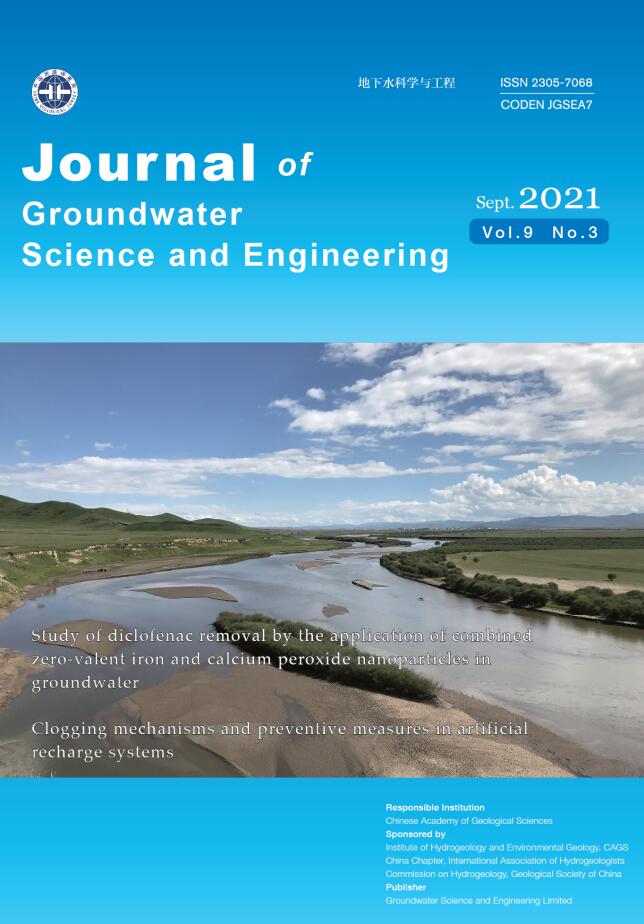

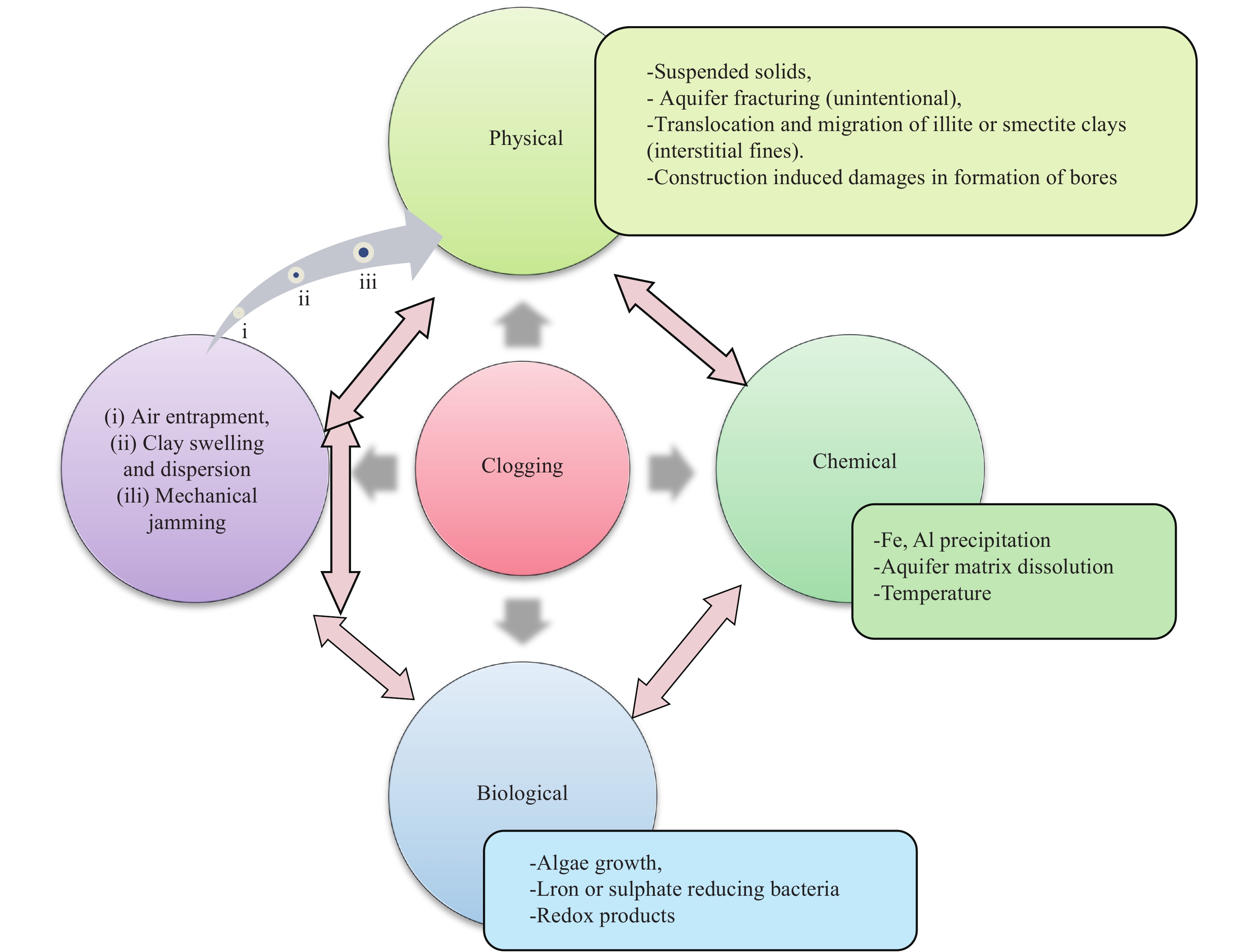

 DownLoad:
DownLoad:
